#avgeekschoolofknowledge
Photo

Not all STOL airliner projects of the late 1960s and early 1970s were jets. In the late 1950s, Charles #Breguet worked on a four engine transport that not only utilized the propwash to "blow" the wing surface and its flaps, but had turboprop engines that were cross linked by a drive shaft to minimize impacts from engine failure. The ultimate development over a series of prototypes resulted in the #Breguet941. The increase in air travel in the 1960s meant that STOL airliners were one way of increasing airport capacity. Some airports even had STOL runways (LGA and DFW, for example). City center "STOLport" facilities were envisaged as helping offload airport traffic. McDonnell Aircraft obtained a license to market and build the aircraft for the US market as the McDonnell 188. Both #American #Airlines and #Eastern Air Lines tested the concept on a very limited basis particularly in the US Northeast corridor. The #McDonnell188 had four abreast seating with accommodation for 57 passengers using less than 1000 feet of runway to fly 500 miles. The fuselage was square section, so it was not pressurized. McDonnell did have plans for a pressurized version, the McDonnell 188E. The 188 was much smaller than the previous STOL airliner concepts I've posted, seating only 1/3 to 1/2 as many passengers as the previous designs I talked about. But it would have been ready for production before its jet STOL competitors. Passenger appeal wasn't great and the innovative cross shaft system added weight and maintenance complexity which in turn raised seat-mile costs. No orders resulted and the aircraft ended up with the French Air Force which withdrew them from use in 1974 due to the aircraft being maintenance intensive. Now I've got one more jet design and one more turboprop design to discuss, but keep in mind that these concepts were the focus of considerable effort by many companies at the same time the #BAe146 began development as the Hawker Siddeley HS.146. #avgeek #aviation #aircraft #planeporn #instaplane #McDonnellDouglas #instagramaviation #splendid_transport #instaaviation #aviationlovers #flight #AvgeekSchoolofKnowledge #AvGeekNation https://www.instagram.com/p/CfIijbmLRZ-/?igshid=NGJjMDIxMWI=
#breguet#breguet941#american#airlines#eastern#mcdonnell188#bae146#avgeek#aviation#aircraft#planeporn#instaplane#mcdonnelldouglas#instagramaviation#splendid_transport#instaaviation#aviationlovers#flight#avgeekschoolofknowledge#avgeeknation
16 notes
·
View notes
Photo
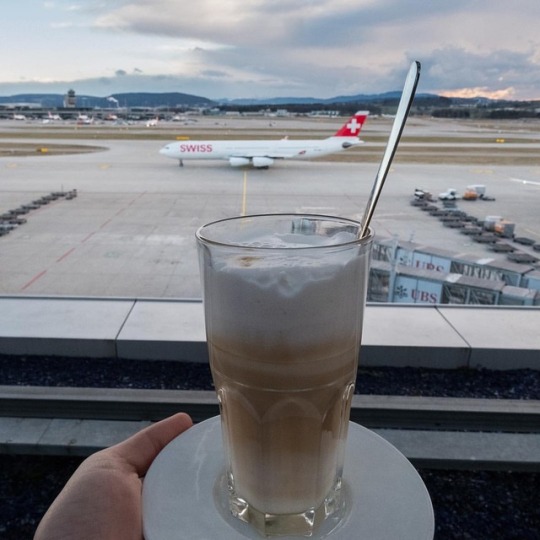
Кофе и самолёты . . . . #Aviation #Airplanes #PlaneLovers #AvGeek #AviationGeek #AvGeekSchoolofKnowledge #AirplanesYo #InstagramAviation @megaplane @zurichairport #swiss #inlovewithswitzerland @myswitzerland (at Zürich Airport)
#airplanes#instagramaviation#avgeekschoolofknowledge#planelovers#avgeek#airplanesyo#aviation#swiss#aviationgeek#inlovewithswitzerland
0 notes
Text

Here's a rare bird these days- a non-winglet equipped Boeing 737-900. Not a -900ER, but a straight -900, of which only 52 or so were built before being replaced by the more capable 737-900ER. Alaska Airlines has 12 737-900s in its fleet compared to 76 active 737-900ERs (3 parked as of 4Q2021).
This particular aircraft departing Sea-Tac early in the morning is N305AS, one of the three former prototype aircraft used in the 737-900 flight test program- all three are now operated by Alaska- N302AS, N303AS and N305AS and were the first three -900s built.
The lack of winglets is due to having an earlier style of wing structure that would make retrofitting winglets a lower return on investment compared to the early 900ERs that were retrofitted with winglets.
In Alaska's fleet, the -900s are still very useful on routes where range is not as critical- primarily non-transcon trunk routes and up and down the West Coast.
The 737-900 had its origins as an aircraft with the 737-800's capacity but with more leg room. In a two-class configuration, the limitations of the -900 were mininal but for the European inclusive tour operators flying single class configurations, the -900 was limited by the emergency exits. Additionally, in the wake of the 2003 Air Midwest crash in Charlotte, the standard passenger weight was revised for weight and balance purposes (170 in the summer, 175 in the winter, to 190 in the summer, 195 in the winter) which had the effect of shortening the range of all passenger aircraft.
For Alaska, this meant the -900 couldn't do transcons with a full load and the 737-800 was ordered to fill that role until the arrival of the 737-900ER with featured a beefed up structure and modifications to the wing and flap scheduling to improve its field performance (the first big change to the 737NG wing).
#Boeing #737 #Alaska #AlaskaAirlines #N305AS
#instagramaviation #splendid_transport #instaaviation #aviationlovers #aviationphotography #flight
#AvGeeksAero #AvgeekSchoolofKnowledge #AvGeekNation
1 note
·
View note
Photo
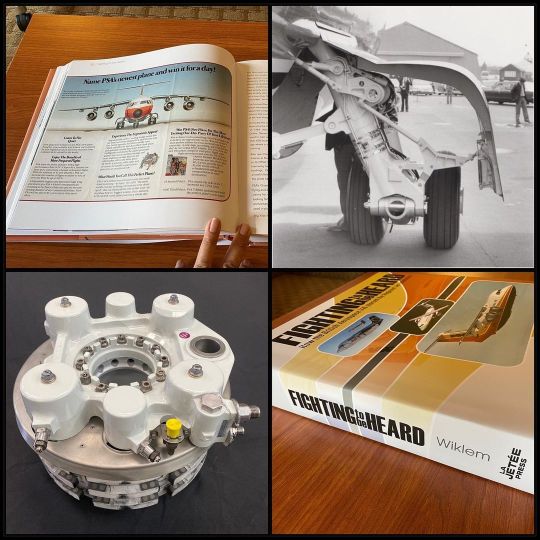
The first production commercial aircraft to use carbon brakes was Concorde, but the second production commercial aircraft to have carbon brakes was the British Aerospace BAe-146 which first flew in September 1981. Previously seen only high performance military aircraft, carbon brakes on the 146 was really the first widespread commercial aircraft use given the minuscule production numbers of Concorde. Comparing conventional steel brakes with carbon brakes for the same aircraft, carbon brakes are 40% lighter with better heat absorption. At the time of the 146’s genesis, carbon brakes are considerably more expensive than steel brakes, so it’s use on a short haul jetliner was unprecedented at the time. I’ve posted before about our new aviation publishing venture, La Jetee Press, and our inaugural book,“Fighting to be Heard: How the British Aerospace Bae-146 Started the Regional Jet Revolution” by Brian Wiklem. In the next several weeks, I’ll be talking more about the BAe-146, Brian Wiklem’s book, as well as giving you a feel for the mission and passion of La Jetee Press. Humor me the self promotion, but as a life-long avgeek, this book and our enterprise is an exciting time for me I absolutely have to share with everyone. You can order Brian’s book at www.lajeteepress.com. #avgeek #aviation #aircraft #planeporn #LaJeteePress #HawkerSiddeley #BritishAerospace #BAe #BAe146 #instaaviation #aviationlovers #flight #AvGeekSchoolofKnowledge #AvGeekNation #TeamAvGeek https://www.instagram.com/p/Ced6FSJuXaG/?igshid=NGJjMDIxMWI=
#avgeek#aviation#aircraft#planeporn#lajeteepress#hawkersiddeley#britishaerospace#bae#bae146#instaaviation#aviationlovers#flight#avgeekschoolofknowledge#avgeeknation#teamavgeek
17 notes
·
View notes
Photo

One of the more unusual BAe-146 users was AirPac, a charter #airline based in Dutch Harbor, Alaska. Established in 1978, #AirPac started with a Swearingen Metro II and a Cessna 414 on services between Dutch Harbor and Anchorage. The addition of a Fokker F27 allowed for increased cargo operations during the seafood season and extension of charter operations to other airports. Jet operations into Dutch Harbor were the next step. At the time, Dutch Harbor had a 3950' gravel runway and after much study, the #BAe146 was the best candidate and a single example was acquired. It was the first jet service at Dutch Harbor and the flying time to ANC was cut from 3:00 to 1:15. In 1984, the Alaska Transport Commission took AirPac to court for operating a supplemental base in Anchorage, a violation of its state taxi charter. Reeve Aleutian Airways filed an amicus brief, hoping to knock AirPac out as a competitor. The case went before the Alaska Supreme Court. The ATC's case was based on the 146 spending 80% of the time at ANC, all the 146 pilots lived in Anchorage, AirPac used an Anchorage telephone number and had a full time employee at ANC to handle passengers. Since AirPac was an air taxi outfit, it did not have a ticketing counter at the airport, so one of their jobs was to meet passengers and direct them to their AirPac flight. AirPac responded they had to book flights back to Dutch Harbor to be economically viable and at the time, phone service to Dutch Harbor was unreliable, so an Anchorage phone number was needed. AirPac also argued that not being allowed to market flights back to Dutch Harbor infringed in free speech. The Alaskan Supreme Court sided with AirPac. The photo is of AirPac's #BAe-146. The lettering on the main landing gear door is "The Alaska Connection". The second image is the full page on AirPac's BAe-146 from “Fighting to be Heard: How the British Aerospace Bae-146 Started the Regional Jet Revolution” by Brian Wiklem, the inaugural title from our new aviation publishing house, #LaJeteePress (www.lajeteepress.com). #avgeek #aviation #aircraft #planeporn #BritishAerospace #aviationlovers #flight #AvGeekSchoolofKnowledge https://www.instagram.com/p/CehMW9buxLL/?igshid=NGJjMDIxMWI=
#airline#airpac#bae146#bae#lajeteepress#avgeek#aviation#aircraft#planeporn#britishaerospace#aviationlovers#flight#avgeekschoolofknowledge
13 notes
·
View notes
Photo

In the early 1970s at the time of the launch of the British Aerospace BAe-146 (back then still Hawker Siddeley), there was considerable interest in STOL airliners in the industry. This particular design proposal was the Boeing/Aeritalia 751, a joint venture with the Italian aircraft company Aeritalia which at the time of this STOL airliner proposal, had just been formed with the merger of Fiat Aviazone and Aerfer. Aerfer built Italy's first supersonic jet, the Saggitario. Aeritalia merged with Aermacchi in 1990 to create Alenia Aeronautica. Work on the 751 began in 1970 with 40 Aeritalia engineers assigned to Boeing Renton. Unlike the BAe-146 though, it was a larger aircraft, seating 100-150 passengers. It would have had the capability of carrying 100 passengers 500 miles using runways under 2000 feet long. The design would have used the jet augmenter wing concept, which takes the concept of blown flaps further by arranging the exit slots in a way that boosts the airflow over the wing by pulling in ambient air and augmenting the airflow over the flaps. NASA tested a jet augmenter wing STOL on a converted DHC-6 Buffalo. However, the Arab Oil embargo in 1973 and subsequent rise in fuel prices led the 751 being quietly shelved. One of the drawbacks of jet augmenter designs is the added weight of the systems needed to allow STOL performance of the wing. The short range of the 751 also lessened its commercial appeal. It wasn't all for naught, though. Working with Aeritalia proved beneficial and in 1974, Boeing and Aeritalia signed a risk-sharing agreement to work on a new widebody twin that eventually became the Boeing 767. It was a new approach for Boeing, from the start of the design process, the 767 had to have better operating costs than any other previous design. #avgeek #aviation #aircraft #planeporn #instaplane #BAESystems #BritishAerospace #BAe146 #Boeing #Aeritalia #instagramaviation #splendid_transport #instaaviation #aviationlovers #flight #AvgeekSchoolofKnowledge #AvGeekNation https://www.instagram.com/p/CfB_rsVL-0S/?igshid=NGJjMDIxMWI=
#avgeek#aviation#aircraft#planeporn#instaplane#baesystems#britishaerospace#bae146#boeing#aeritalia#instagramaviation#splendid_transport#instaaviation#aviationlovers#flight#avgeekschoolofknowledge#avgeeknation
7 notes
·
View notes
Photo

I'd already posted about the only Alaskan BAe-146 operator, AirPac, that routinely operated a 146-100 into Dutch Harbor back when its runway was still gravel. Routine rough field operations in the 146 was something envisioned from the get go in the 146 program but it was never fully realized except by niche operators. Like, only two. One was AirPac, the other was Australian operator Cobham (formerly National Jet Systems) that used its 146s to support the mining industry in Western Australia. The top part of this image is from BAe and is a striking photo of a 146-100 during rough field testing. It's likely (thanks to Brian's guidance when I asked him) G-OPSA which was LN2 and was leased to PSA for crew training. Three 146-100s flew with PSA and could be identified as the PSA cheatlines were straight across the nose whereas the 146-200s, the cheatlines curved under the nose. The lower half of this image and is from Cobham showing one of their 146-200s operating from a gravel strip at a remote mining site in Western Australia. On 4 November 2021, the final Cobham 146 flight touched down in Perth after a fly-in/fly-out charter flight to a mining site at Murrin Murrin for Minara Resources. Their mining operation at Murrin Murrin extracts nickel and cobalt. Beginning in 1990, Cobham operated a total of 33 BAe-146s in Western #Australia with some of the aircraft fitted out for rough field operations to support the Australian mining industry. At its height, Cobham had 16 146s operating in the region. Cobham has replaced the BAe-146 with the E190 and Q400 to serve the mining industry, but I'm not aware of any rough field capability for those aircraft unless the runways at the mining sites have been paved. #avgeek #aviation #aircraft #planeporn #instaplane #BAESystems #BritishAerospace #BAe146 #Cobham #NationalJetSystems #instagramaviation #splendid_transport #instaaviation #aviationlovers #aviationphotography #flight #AvGeeksAero #AvgeekSchoolofKnowledge #AvGeekNation https://www.instagram.com/p/Ce9uOM1vvh3/?igshid=NGJjMDIxMWI=
#australia#avgeek#aviation#aircraft#planeporn#instaplane#baesystems#britishaerospace#bae146#cobham#nationaljetsystems#instagramaviation#splendid_transport#instaaviation#aviationlovers#aviationphotography#flight#avgeeksaero#avgeekschoolofknowledge#avgeeknation
7 notes
·
View notes
Photo

On a Facebook aviation group a map image from around 1981-82 of the area around the old Greater Southwest International Airport was posted. I overlaid it on a current Google Earth screen shot and labeled some salient features. I didn’t move to the DFW area until 1989, so it’s kinda cool that GSW/Amon Carter Field lasted into the 1980s (even though closed) years after DFW International Airport opened in 1973. The east-west freeway is SH183 (Airport Freeway). There used to be a tunnel where it crossed under 17/35 of GSW/Amon Carter Field. Spur 459 on the upper right is International Parkway and the south entrance to DFW. The DFW Rental Car Center is visible in the upper right. Runway 17/35 is now Amon Carter Boulevard, but the very north end of 17/35 and it’s associated taxiway/hold pad you can still see when you fly into and out of DFW. If you're on the ramp going to SH360 south from SH183 westbound or coming south out of International Parkway, you can see it on your right as well. The old American Airlines HQ complex is on the west side of Amon Carter Boulevard. For years the trees that lined the GSW access road were still visible well into the early 2000s until some commercial buildings were built in the area. Satellite images of when the SE corner of 183/360 was an empty field you can see traces of Runway 13/31. The new Skyview 8 HQ complex is south of the CR Smith Museum. Skyview 3/4 are north of the Museum and American Airlines Integrated Operations Center (IOC) is Skyview 2. (For those curious, Skyview 1 is the AA Reservations Center) The ZFW ARTCC is near the CR Smith Museum as well. The rail line south of the airport perimeter is the commuter rail line now that connects downtown Fort Worth to downtown Dallas. Just to the west of where the threshold of 35 is Centerport Station for the Trinity Railway Express. #avgeek #aviation #DFW #DallasFortWorth #Texas #airport #instagramaviation #splendid_transport #instaaviation #aviationlovers #aviationphotography #flight #AvGeeksAero #AvgeekSchoolofKnowledge #AvGeekNation https://www.instagram.com/p/CeqvjLbuhG1/?igshid=NGJjMDIxMWI=
#avgeek#aviation#dfw#dallasfortworth#texas#airport#instagramaviation#splendid_transport#instaaviation#aviationlovers#aviationphotography#flight#avgeeksaero#avgeekschoolofknowledge#avgeeknation
9 notes
·
View notes
Photo

My prior post about the 1970 Boeing/Aeritalia 751 STOL airliner that would have been a contemporary of the BAe-146 mentioned that it used jet augmentor wing technology. The jet augmentor wing was more than just blown flaps like what was used on the F-104 Starfighter or the Blackburn Buccaneer. The jet efflux in the augmentor wing was channeled between a pair of flaps which was slotted to bring in ambient air and boost the air flow through the flaps. The NASA image on the right shows the flap opening on the trailing edge of the C-8A Augmentor Wing Jet research aircraft. That acted like a jet exhaust. Note also the vectored nozzle on the side of the engine nacelle that was also a feature of this research aircraft. The schematic on the right shows the engine installation and I've highlighted in blue (cool air flow) and red (hot air flow) the efflux components. A Rolls Royce Spey Mk.511 as used on the Gulfstream II/III was the basis. Bypass flow from the engine was used for the wing augmentor. Using cool bypass flow saved on the need for heat protection. The hot section exhaust was sent through two vectored nozzles based on the vectoring nozzles of the Pegasus engine used on the Harrier. Because the role of the aircraft was to study low speed handling, the landing gear and forward slats were fixed and the augmentor flap was deflectable but not fully retractable. Cross bleed air was used to maintain flow the augmentor flaps in the event of a single engine failure. Some asymmetric lift still occurred but could be countered by differential nozzle deflection. This testbed flow in the early 1970s and one outcome of the joint research work between Canada and NASA was that jet augmentor wing aircraft were loud which would have limited their commercial appeal. Noise was something that was a concern during the design of the BAe-146 as well as other proposed STOL airliners of the early 1970s. #avgeek #aviation #aircraft #planeporn #instaplane #NASA #Canada #DHC5 #Buffalo #C8 #DeHavillandCanada #RollsRoyce #instagramaviation #splendid_transport #instaaviation #aviationlovers #flight #AvgeekSchoolofKnowledge #AvGeekNation https://www.instagram.com/p/CfCoBOEPB6v/?igshid=NGJjMDIxMWI=
#avgeek#aviation#aircraft#planeporn#instaplane#nasa#canada#dhc5#buffalo#c8#dehavillandcanada#rollsroyce#instagramaviation#splendid_transport#instaaviation#aviationlovers#flight#avgeekschoolofknowledge#avgeeknation
4 notes
·
View notes
Photo
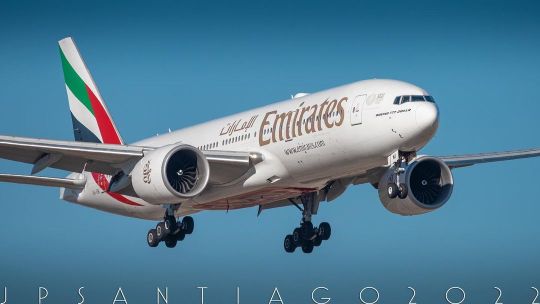
Emirates 221 Heavy nears the end of its 14.5 hour flight from DXB to DFW. You can clearly see the complex-shaped swept blades on the fan of the massive GE90-110B1 engines. When the second generation of GE90 engines for the 777-300ER and 777-200LR were under development, GE looked using conventional "radial" blades like that used on the GE90-94B used on the 777-200(ER), but using advanced computational fluid modeling techniques, found that the complex-shaped swept blades were more efficient and increased the air mass flow through the engine. This translates into a thrust gain of 1000-2000 lbs *just* from the fan blade shape- that excludes the improvements made to the GE90 core. #Avgeek #aviation #aircraft #planeporn #DFW #dfwavgeek #airport #planespotting #Boeing #777 #A6EWI #Emirates #Airlines #instagramaviation #splendid_transport #aviationlovers #aviationphotography #flight #AvGeeksAero #AvgeekSchoolofKnowledge #AvGeekNation #TeamAvGeek (at DFW Airport) https://www.instagram.com/p/Cgp4gd3sgZR/?igshid=NGJjMDIxMWI=
#avgeek#aviation#aircraft#planeporn#dfw#dfwavgeek#airport#planespotting#boeing#777#a6ewi#emirates#airlines#instagramaviation#splendid_transport#aviationlovers#aviationphotography#flight#avgeeksaero#avgeekschoolofknowledge#avgeeknation#teamavgeek
4 notes
·
View notes
Photo
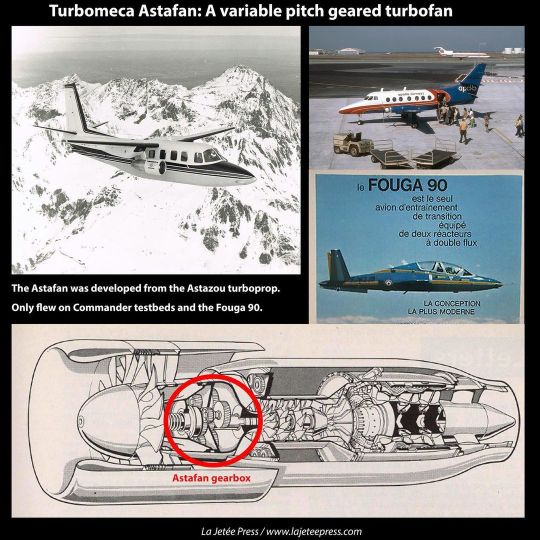
Before we move on in our survey of geared turbofans that will bring us to the Lycoming ALF 502 of the BAe-146 and the new PW1000G, let’s take a side trip from the Turbomeca Aubsique engine to another Turbomeca geared turbofan that did not reach production, the Astafan. I previously posted that the canceled Aerospatiale A.904 STOL airliner was to use a variable pitch geared turbofan called the M45SD that was based on the M45 engine used on the VFW614 airliner. A variable pitch front fan is exceedingly rare in jet engine technology- the M45SD was bench tested but never flew. But the Astafan did fly. On two different aircraft. The Astafan was based on the Astazou turboprop which was used on many aircraft of the 1960s and 1970s but most notably on the early versions of the Handley Page (later BAe) Jetstream. The Astazou first flew in 1957 and was used in both turboprop and turboshaft applications. It was easy to fit a gearbox to the Astazou core sized for the variable pitch front fan to create the Astafan. On the lower schematic, I’ve highlighted the location of the Astafan’s gearbox. Turbomeca tested the engine on two Rockwell Twin Commanders that had the piston engines removed but fairings for the main landing gears. The Astafan engines were slung underwing from pylons. Compared to turbojets of similar size, the Astafan was quieter and more fuel efficient. It first ran in 1969 but never reached production. The machinery for both the front fan gearbox and the variable pitch fan made the engine heavier than comparable designs and there were concerns about the complexity of maintenance. The only other aircraft to fly with the Astafan was the Fouga 90 which was planned as a modern successor to the Magister jet trainer. First flying in 1978, the Alpha Jet was selected instead of the Fouga 90 for the Armee de l’Air’s jet training requirements. Only a single Fouga 90 was built. (Jetstream photo: Richard Silagi) #avgeek #aviation #aircraft #planeporn #LaJeteePress #Turbomeca #Astafan #Astazou #turboprop #Jetstream #Aerospatiale #Fouga #Safran #instaaviation #aviationlovers #flight #AvGeekSchoolofKnowledge #AvGeekNation #TeamAvGeek https://www.instagram.com/p/Cfre_oiuOyP/?igshid=NGJjMDIxMWI=
#avgeek#aviation#aircraft#planeporn#lajeteepress#turbomeca#astafan#astazou#turboprop#jetstream#aerospatiale#fouga#safran#instaaviation#aviationlovers#flight#avgeekschoolofknowledge#avgeeknation#teamavgeek
2 notes
·
View notes
Photo

Before I can talk more about the Lycoming ALF 502 geared turbofan used on the BAe-146 and the challenges in the development of the Pratt & Whitney PW1000G engine, we gotta go all the way back to the early 1960s to the very first production geared turbofan, the Turbomeca Aubisque engine. The Aubisque engine only had one application, it was the initial engine used on the Saab 105 trainer/light attack aircraft and was designated as the RM9 in Swedish service. Developing only 1600 lbs of thrust, the Aubisque was developed from the Turbomeca Bastan turboprop that was used on the Nord 262 commuter airliner. A turboprop engine is in a lot of ways like a geared turbofan only unducted- the propeller has to spin at a slower speed that turbine in the core. As propeller speeds are much lower than the fan speed of turbofan engines, gearbox technology for turboprop engines was relatively mature. In developing the Aubisque, Turbomeca used a smaller gearbox to turn the fan, creating the world's first geared turbofan. The Aubisque engine first ran in 1961 and the Saab 105 prototype made its first flight in 1963. The later export and light attack versions of the Saab 105 used the GE J85 engine. By 1993, the Aubisque engines were getting difficult to maintain and those Saab 105s with the Aubisque were re-engined with the Williams FJ44 engine, the first FJ44-powered Saab 105s flying in 1996. Unmodernized Aubisque powered Saab 105s have since been retired from service. #avgeek #aviation #aircraft #planeporn #LaJeteePress #Turbomeca #Aubisque #Bastan #turboprop #Nord262 #Saab #Saab105 #Flygvapnet #instaaviation #aviationlovers #flight (Nord 262 photo: Jay Selman) #AvGeekSchoolofKnowledge #AvGeekNation #TeamAvGeek https://www.instagram.com/p/CfqCQj_sC2W/?igshid=NGJjMDIxMWI=
#avgeek#aviation#aircraft#planeporn#lajeteepress#turbomeca#aubisque#bastan#turboprop#nord262#saab#saab105#flygvapnet#instaaviation#aviationlovers#flight#avgeekschoolofknowledge#avgeeknation#teamavgeek
2 notes
·
View notes
Photo
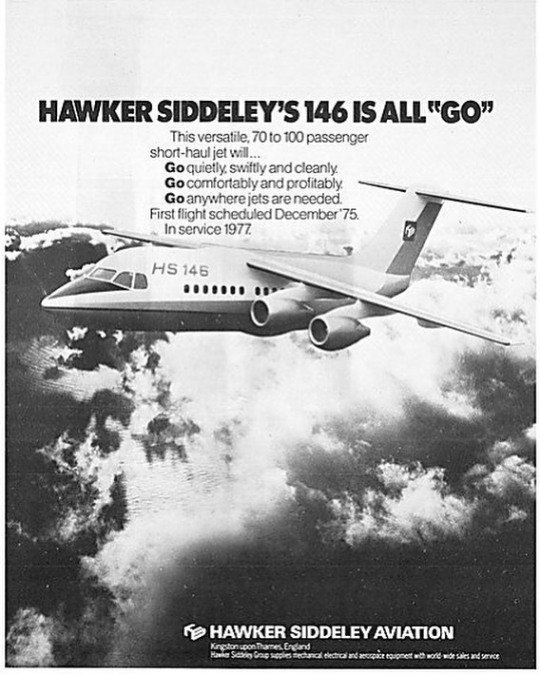
This Hawker Siddeley advertisement ran in the November 22, 1973, issue of Flight magazine. The dates on this ad for a projected first flight in December 1975 and an in-service date of 1977 would have happened had it not been for the 1973 Arab Oil Embargo that sent fuel prices in the West skyrocketing. That massive spike in fuel prices and resulting economic downturn led to the STOL airline designs I've been posting about to get shelved- the Boeing/Aeritalia 751, the BAC QSTOL, and the Aerospatiale A.904. That would have been a fate shared by the Hawker Siddeley HS.146 as well. With oil prices shooting up 400%, the Hawker board was considering terminating the program. A very public battle erupted to save the HS.146 program. Workers staged a "work-in"- refusing to stop development work on the jet. Employees went as far as to hide engineering drawings and tooling to prevent the Hawker board from terminating the program. It wasn't until after the nationalization of the British aircraft industry with the merger of Hawker and BAC to form British Aerospace that the jet was given the green light to proceed in 1978 as the BAe-146. The first chapter of "Fighting to be Heard" is an very riveting account of the heated debate that went on with the Hawker board, the British government, the taxpayers and the employees working on the 146 all engaged in. I think we'd be hard pressed to find another commercial airliner program that was born out such intense political and managerial strife. There were so many points that the 146 could have been canceled for good and it would have joined the other canceled STOL airliners I've posted about the last several days. But that 1978 go ahead from the British government was only the first of many hurdles the BAe-146 had to overcome to enter service. Get your copy at www.lajeteepress.com! Two editions to choose from, either are handsome additions to your aviation library. #avgeek #aviation #aircraft #planeporn #LaJeteePress #BritishAerospace #BAe #BAe146 #instaaviation #aviationlovers #flight #AvGeekSchoolofKnowledge #AvGeekNation #TeamAvGeek https://www.instagram.com/p/CfLC92MrREa/?igshid=NGJjMDIxMWI=
#avgeek#aviation#aircraft#planeporn#lajeteepress#britishaerospace#bae#bae146#instaaviation#aviationlovers#flight#avgeekschoolofknowledge#avgeeknation#teamavgeek
5 notes
·
View notes
Photo

More from my aviation multiverse where the BAe-146 was used by more airlines than what happened on our timeline. This time, it's Ozark. GO GETTERS GO OZARK! In March 1972, St. Louis-based Ozark Air Lines began to use De Havilland DHC-6 Twin Otters on passenger services between Springfield, Illinois, and Chicago's lakefront Meigs Field in competition to a similar service started by the commuter airline Air Illinois. Ozark's services only lasted one year due to financial losses primarily due to high crew salaries- Ozark's pilot contract did not have provisions for proportionally lower wages for flying smaller aircraft. It was one of several attempts by local service carriers to fly smaller aircraft to smaller markets (it was also tried by West Coast/Air West, Frontier, and Texas International as well. Suppose Chicago Meigs Field became something like today's London City Airport instead of getting bulldozed in the middle of the night? Suppose Ozark's original Meigs Field services stayed viable and by the 1980s, Ozark used the quiet STOL capabilities of the BAe-146 to fly into Meigs Field? In our alternate history, Ozark would have a fleet of BAe-146s to support services direct into close-in Meigs Field from points throughout Ozark's network. Imagine that sort of Chicago- with commercial air service from O'Hare, Midway *and* Meigs! Imagine the -200s operating denser routes like STL-CGX, DCA-CGX, LGA-CGX or DTW-CGX with the smaller -100 operating thinner routes like DSM-CGX, IND-CGX, or MCI-CGX. This illustration depicts both the BAe-146-100 and BAe-146-200 as they might have looked in 1985 in Ozark's final colors before their acquisition by TWA in 1986. Learn about real world BAe-146s! www.lajeteepress.com "Fighting to be Heard: How the British Aerospace 146 Started the Regional Jet Revolution" by Brian Wiklem! GET UP AND GO! GO GETTERS GO BUY THIS BOOK! #avgeek #aviation #aircraft #planeporn #thechickenworks (follow this tag to see more of my artwork) #BritishAerospace #BAe #BAe146 #Ozark #Airlines #aviationlovers #flight #Adobe #Illustrator #aviationart #aviationillustration #IllustratorCC #Avgeekschoolofknowledge #AvGeekNation https://www.instagram.com/p/CfF5lH2LUhP/?igshid=NGJjMDIxMWI=
#avgeek#aviation#aircraft#planeporn#thechickenworks#britishaerospace#bae#bae146#ozark#airlines#aviationlovers#flight#adobe#illustrator#aviationart#aviationillustration#illustratorcc#avgeekschoolofknowledge#avgeeknation
6 notes
·
View notes
Photo
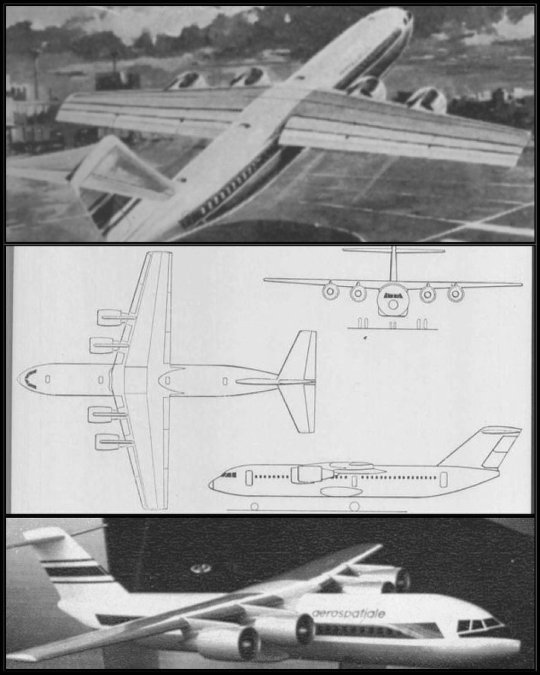
More on my continuing review of STOL airliner projects of the early 1970s that would have been competitors to the BAe-146 had it gone into production as originally planned in the mid-1970s instead of the early 1980s as events transpired. This is the fascinating Aerospatiale A.904 proposal from 1971. It was similarly sized as the BAC QSTOL I posted about yesterday- about 100-150 passengers over 500-600 miles range. While the Boeing/Aeritalia 751 used jet augmentor wing technology, the BAC QSTOL used highly efficient flaps and eschewed any complex technology, the A.904 was somewhere in between. Like the McDonnell Douglas YC-15 and the current C-17 Globemaster III, the A.904 would have used externally blown flaps where the jet efflux would have flowed across very generous full span double slotted flaps. The most interesting aspect of the A.904 project was its planned SNECMA M45SD engines. The M45 was a joint Rolls-Royce/SNECMA venture for a small turbofan engine that used on the VFW 614 jetliner. The M45SD derivative was designed from the outset to be an ultraquiet jet engine. The M45 was a planned family of engines but only the M45H for the VFW 614 went into production. The Adour engine of the SEPECAT Jaguar is a scaled-down M45 engine. The M45SD replaced the front fan of the M45H with variable pitch geared fan that had very broad blades that turned slowly to reduce engine noise. While the BAe-146's Lycoming ALF 502 engines were also geared turbofans, the M45SD added variable pitch to the front fan like a propeller or ducted fan. Adjusting the pitch of the front fan allowed the core to have a lower velocity hot exhaust, which further improved the engine's low noise signature. In many ways A.904's M45SD engines were a hybrid of a ducted fan and a geared turbofan. Like many 1970s STOL airliner projects, the A.904 quietly got shelved in the wake of the 1973 Arab Oil Embargo as airlines focused on cost efficiency over special capabilities. #avgeek #aviation #aircraft #planeporn #instaplane #BritishAerospace #BAe146 #Aerospatiale #A904 #instagramaviation #splendid_transport #aviationlovers #flight #AvgeekSchoolofKnowledge #AvGeekNation https://www.instagram.com/p/CfFxTQPLn__/?igshid=NGJjMDIxMWI=
#avgeek#aviation#aircraft#planeporn#instaplane#britishaerospace#bae146#aerospatiale#a904#instagramaviation#splendid_transport#aviationlovers#flight#avgeekschoolofknowledge#avgeeknation
4 notes
·
View notes
Photo

I'd already posted about how STOL airliners were fashion at the time of the genesis of the BAe-146 in the early 1970s (which at the time was still the Hawker Siddeley HS.146). I've already talked about jet augmentor wings and the Boeing/Aeritalia 751, what we have here is the BAC QSTOL, a design that is often mistaken as a predecessor design to the 146. It's not connected to the BAe-146 at all. BAC was the result of the 1960 merger of Vickers, English Electric and Bristol Aircraft. The QSTOL proposal dates from *before* Hawker Siddeley merged with BAC in 1977 to form British Aerospace. BAC astutely realized that a practical #STOL airliner had to be quiet and simple. That mean jet augmentor wing technology was out. It was loud and complex, my prior post about the NASA Buffalo jet augmentor wing testbed had shown the limitations of that technology which the Boeing/Aeritalia 751 would have used. Simplicity also meant reliability in BAC's view. They also felt that an STOL optimized aircraft had a 25% higher operating cost than a conventional similarly sized jetliner, so the QSTOL's design was straightforward with no complex elements. The higher operating costs would be offset by being quieter and more reliable, allowing higher frequency of use, even at noise sensitive #airports. QSTOL was larger than the BAe-146, with seating up to 140 passengers but BAC was aiming for operations off 2000 foot runways using generous trailing edge flaps. Conceptually it was a lot more like the BAe-146 than the Boeing/Aeritallia 751. Like many other proposed STOL designs, QSTOL died quietly as a paper project in the wake of the 1973 Arab oil embargo as fuel prices skyrocketed. What airlines wanted was not capability but efficiency. #avgeek #aviation #aircraft #planeporn #instaplane #BAESystems #BritishAerospace #BAe146 #BAC #BritishAircraftCorporation #QSTOL #instagramaviation #splendid_transport #instaaviation #aviationlovers #flight #AvgeekSchoolofKnowledge #AvGeekNation https://www.instagram.com/p/CfDUyYWL7tv/?igshid=NGJjMDIxMWI=
#stol#airports#avgeek#aviation#aircraft#planeporn#instaplane#baesystems#britishaerospace#bae146#bac#britishaircraftcorporation#qstol#instagramaviation#splendid_transport#instaaviation#aviationlovers#flight#avgeekschoolofknowledge#avgeeknation
5 notes
·
View notes